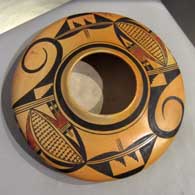Nampeyo of Hano
1859-1943
Hopi-Tewa


Nampeyo of Hano was born around 1859 in the First Mesa village of Hano. Her mother was White Corn of the Tewa Corn Clan. Her father was Quootsva of the Walpi Snake Clan. According to tradition, she was raised in the Tewa Corn Clan at Hano. She and her brothers, Kano and Patuntupi never went to school. On the other hand, her brother, Tom Polacca, did go to school and learned to speak English.
The Hopi language in those days was not yet a written language and Nampeyo never learned to speak, read or write English. She grew up speaking Tewa and Hopi. She learned the basics of the Hopi art of pottery making from her father's mother and gathered pointers from other experienced Hopi-Tewa and Walpi potters.
By 1881 she'd already earned a reputation as one of Hopi's finest potters. Up until then most of her pottery was based on the styles and designs of Walpi. Then she began the change to doing her painting directly on the highly polished surface of her Jeddito yellow clay, just as the potters of ancient Sikyátki and Awat'ovi had done. She was encouraged to do this by Thomas Varker Keam, the proprietor of the Keams Canyon Trading Post, and his assistant, Alexander Stephen. Between 1875 and 1892 almost the entire pottery output of Nampeyo was purchased, en masse, by Keam. In 1892 Keam sold his entire collection of modern and ancient Hopi pottery to the Essex-Peabody Museum of Harvard College and it was transferred there.
Nampeyo married Lesou, her second husband, in 1878. Annie, their first daughter, was born in 1884, William Lesso in 1893, Nellie in 1896, Wesley in 1899 and Fannie in 1900.
There is an oft-repeated story that Lesou was employed by J. Walter Fewkes during his excavation of the ruins of Sikyátki in 1895 and it was there that the ancient Sikyátki designs and pottery styles were found. However, Sikyátki styles and designs had been on the market for ten to fifteen years and were already becoming known as "revival" pottery. Other research has shown that Lesou never worked for Fewkes. About 1880 anthropologist Alexander Stephen came to Keams Canyon and began to investigate the area. He and trader Thomas Keam began encouraging the potters of Walpi and Hano to make pottery with designs found among the ruins of Awatovi and Sikyátki, where the ground was profusely littered with ancient potsherds. Nampeyo copied those designs on paper and later incorporated many of them into her catalog of decorations. She also figured out the style of pottery that each of those designs had been painted on and by the late 1890s she'd become quite famous for her work. She also studied the intricacies of the ancient potsherds and searched out the various clays used to produce and decorate them. She worked out the firing techniques used by the ancients to produce the high-fired sherds that she was finding all over the ground.
Nampeyo and her family traveled to Chicago in 1898 and showed her pottery to the world. Between 1905 and 1907 she was the Fred Harvey "Artist in Residence" at the Grand Canyon Lodge. She returned to Chicago in 1910 to exhibit her work at the United States Land and Irrigation Exposition.
In the end it's not that Nampeyo invented pottery or that she was self-taught, it's that she was the right person in the right place at the right time to revive the ancient shapes and designs. She deviated slightly from the especially isolated and conservative Hopi norm in her assimilation and adaptation of these ancient styles and designs. Nampeyo might not have begun the movement now known as Sikyátki Revival but she became its most famous practitioner and almost single-handedly ignited the renaissance of Hopi pottery making at the turn of the 20th century.
Nampeyo was diagnosed with trachoma in her early years and was essentially blind for the last 20 years of her life. However, she was so adept at making her pots that blindness didn't slow her down much and didn't hurt the quality of her pots in any way. She did have other members of her family do the painting for her, especially her youngest daughter Fannie. In her last few days, she left the Corn Clan house in Hano and moved down to her son Wesley's home in Polacca. It was in Wesley and Cecilia's bed that she died in 1942, leaving behind more than 40 direct descendants to carry on the tradition she pioneered.
Photo of Nampeyo is in the Public Domain of the United States.
(505) 986-1234 - www.andreafisherpottery.com - All Rights Reserved
